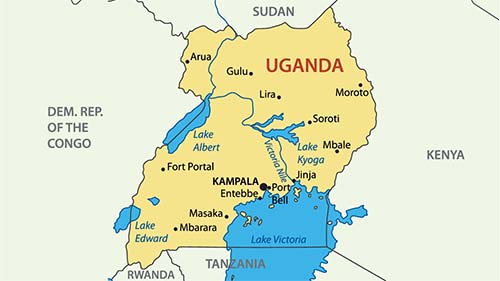Cómo Uganda no deja a nadie atrás en la lucha contra el VIH
Uganda ha diseñado un sistema innovador para garantizar que incluso las personas que viven en comunidades rurales remotas puedan recibir servicios de prevención, cuidado y tratamiento del VIH de alta calidad.
Durante más de tres décadas, Uganda se ha visto envuelta en una devastadora epidemia de VIH/SIDA. En la actualidad, alrededor de 1 350 000 personas viven con VIH en el país, y se estima que hay 33 nuevas infecciones por VIH al día en los jóvenes de entre 15 y 24 años de edad.Pero Uganda ha estado luchando y, siendo muy consciente de los objetivos de ONUSIDA (UNAIDS) sobre el control epidémico para 2020, ha hecho importantes esfuerzos para contener la propagación ampliando el alcance de sus servicios de prevención, cuidado y tratamiento del VIH. “Uganda se compromete a alcanzar los objetivos 90-90-90 globales de ONUSIDA”, afirma Charles Kiyaga, coordinador nacional de EID/VL de transporte de muestras en el Ministerio de Salud de Uganda. Los objetivos 90-90-90 pretenden garantizar que para el 2020 el 90 % de todas las personas que viven con VIH conozcan su estado de VIH; el 90 % de todas las personas con infección por VIH diagnosticada reciba tratamiento antirretrovírico ininterrumpido y el 90 % de todas las personas que reciban tratamiento antirretroviral tengan supresión de carga vírica.
INSERTAR IMAGEN 90 90 90
Llegar a las personas en áreas remotas
El problema al que se enfrenta Uganda es que es un país de alrededor de 43 millones de personas, y muchas de sus comunidades son pobres, vulnerables y viven en zonas rurales remotas.
Así que, ¿cómo demonios se llega a todos aquellos que puedan estar en riesgo de VIH a fin de garantizar que reciban las pruebas y, de ser necesario, el tratamiento antirretrovírico?
Respuesta: se crea una infraestructura innovadora para garantizar que tantas personas como sea posible, donde sea que residan, puedan acceder a servicios de VIH rápidos, efectivos y de alta calidad.
Idea innovadora para transportar muestras de sangre
Eso es justo lo que Uganda ha hecho con su red nacional de transferencia de muestras, que ha tenido un gran éxito en garantizar que las pruebas de las muestras se puedan realizar de forma rápida y eficaz en las diversas ubicaciones de los laboratorios.
Se ha nestablecido en el país alrededor de 100 “centros”, todos con equipos de laboratorio y sirviendo en promedio a 30 instalaciones sanitarias en un radio de 30 km a 40 km. Las muestras procedentes de todos los lugares de Uganda se envían a los centros de prueba en motocicleta, o a los laboratorios de referencia nacionales (“laboratorios centrales de salud pública”) en Butabika, Uganda, por servicio de mensajería. Entre ellas se incluyen muestras para pruebas esenciales de VIH, incluyendo CD4, carga vírica y TB.
Mejoras en los puntos piloto del Nilo Occidental
En Uganda, la red ha transformado tanto el acceso a las pruebas como el diagnóstico y tratamiento del VIH. También ha ayudado al país a dar un paso enorme hacia la consecución de los objetivos 90-90-90 de ONUSIDA.
Sin embargo, cada uno de los sistemas aún se puede mejorar. Por lo tanto, en 2016, el Ministerio de Salud inició un programa piloto de fortalecimiento de los laboratorios en la región de salud del Nilo Occidental de Uganda. El objetivo fue mejorar la eficiencia operativa en los centros de pruebas de VIH con el fin de proporcionar una mayor efectividad de las pruebas y un mejor “seguimiento” de los pacientes.
Con la aplicación del Sistema Empresarial Danaher para impulsar el pensamiento transformacional y el uso de los principios Lean Six Sigma, se celebró un taller de resolución de problemas para asignar los procesos del sistema y destacar en qué lugares los obstáculos estaban provocando ineficiencia. Luego se designó un coordinador y se lo estableció en la región para respaldar a los centros, exigir un mayor uso de los servicios del centro y supervisar la red de transferencia de muestras.
El impacto del coordinador regional
La diferencia que el coordinador marcó en la red del Nilo Occidental fue sorprendente, con resultados que incluyen:
• mejora significativa de la efectividad y la eficiencia de los servicios de laboratorio
• aumento de la demanda de diagnósticos esenciales de VIH
• uso eficaz de los servicios de laboratorio
• reducción significativa del tiempo de respuesta
• mayor uso de los servicios de los laboratorios del centro
• mayor eficiencia y fiabilidad del sistema de transporte del centro.
“En poco tiempo, pudimos ver el impacto que el coordinador regional estaba teniendo”, explica Charles Kiyaga. “El volumen de muestras que fluía a través de los centros aumentó y después de tres meses pudimos ver cómo los centros inactivos o infrautilizados se volvían activos”. También mejoró la capacidad en los centros. “Por ejemplo, la capacidad para realizar pruebas de CD4 no se había utilizado en uno de los centros, pero durante el programa piloto esto cambió”, dice Kiyaga.
Tras el éxito del programa piloto, ahora se recomienda que la coordinación se despliegue hacia el resto de las regiones. Esto respalda el logro de las metas del objetivo 90-90-90 de ONUSIDA para 2020.
La red nacional de transferencia de muestras de Uganda ha sido tan bien recibida que Kiyaga está ayudando a establecer iniciativas similares en otras naciones africanas. “Creemos que este es un sistema revolucionario que cambiará la imagen de los servicios de laboratorio”, dice.
INSERTAR VÍDEO
How Uganda is leaving no-one behind in battle against HIV
Uganda has designed an innovative system to ensure that even people in remote rural communities can receive high quality HIV prevention, care and treatment services.
For over three decades, Uganda has been in the grip of a devastating HIV/AIDS epidemic. Around 1,350,000 people are currently living with HIV in the country, and there are an estimated 33 new HIV infections per day among young people between the ages of 15 and 24. But Uganda has been fighting back and — keenly aware of UNAIDS' goals for epidemic control by 2020 — has been making significant strides to contain the spread by widening the reach of its HIV prevention, care and treatment services. “Uganda is committed to achieving the 90-90-90 global UNAIDS targets,” says Charles Kiyaga, National EID/VL and Sample Transport Coordinator at the Ugandan Ministry of Health. The 90-90-90 targets aim to ensure that by 2020 90% of all people living with HIV will know their HIV status; 90% of all people with diagnosed HIV infection will receive sustained antiretroviral therapy and that 90% of all people receiving antiretroviral therapy will have viral suppression.

Reaching people in remote areas
The problem Uganda faces is that it is a country of around 43 million people; and many of its communities are poor, vulnerable and living in remote rural areas.
So how on earth do you reach everyone who may be at risk of HIV to ensure they are tested and, if necessary, treated with antiretroviral therapy?
Answer: you create innovative infrastructure to ensure that as many people as possible — wherever they live — can access fast, effective and high quality HIV services.
Innovative idea to transport blood samples
That's just what Uganda has done with its National Sample Transfer Network, which has been highly successful in ensuring that sample testing can be carried out quickly and efficiently at a variety of laboratory locations.
Around 100 'Hubs' — all with laboratory equipment and serving an average of 30 health facilities in a radius of 30km-40km — have been set up across the country. Samples from all parts of Uganda are sent to Hub testing centres by motorcycle, or to the national referral laboratories (“Central Public Health Laboratories”) in Butabika, Uganda, by courier. These include samples for essential HIV testing, including CD4, viral load and TB.
West Nile pilot pinpoints improvements
The Network has transformed both HIV testing access and HIV diagnosis and treatment in Uganda. It has also helped the country take a huge step towards realising the UNAIDS 90-90-90 goals.
Yet every system can be improved. So in 2016, the Ministry of Health began a laboratory strengthening pilot in Uganda's West Nile Health Region. The focus was on enhancing operational efficiencies within HIV testing centres to provide greater testing effectiveness and better patient 'follow up’.
By applying the Danaher Business System to power transformational thinking, and with use of lean 6 sigma principles, a problem-solving workshop was held to map the system's processes and highlight where obstacles were causing inefficiencies. Then a co-ordinator was appointed and placed into the region to support the Hubs, call for increased use of Hub services and oversee the Sample Transfer Network.
The impact of the regional co-ordinator
The difference the co-ordinator made to the West Nile network was startling, with results including:
- significant improvement in effectiveness and efficiency of laboratory services
- increase in demand for HIV essential diagnostics
- effective use of laboratory services
- significant reduction in turnaround time
- increased use of Hub laboratory services
- increased efficiency and reliability of the Hub transport system.
“Within a short while, we could see the impact the regional co-ordinator was having,” says Charles Kiyaga. “The volume of samples trickling through the Hubs increased and after three months we could see under-utilised or inactive Hubs becoming active.” Capacity at the Hubs also improved. “For instance, capacity for CD4 testing hadn't been used at one of the Hubs — but during the pilot this changed,” says Kiyaga.
Following the success of the pilot, it's now recommended that co-ordination should be rolled out to the rest of the regions. This supports achievement of UNAIDS 90-90-90 target goals by 2020.
Uganda's National Sample Transfer Network has been so well-received that Kiyaga is now helping establish similar initiatives in other African nations. “We think this is a revolutionary system that will change the face of laboratory services,” he says.
Dr Charles Kiyaga Totle, IAS 2017, Paris.
Talk to an expert about CD4 testing solutions
CD4 Testing in Remote Areas

CD4 testing in remote areas
Follow the links, to learn how Uganda designed an innovative system to ensure that people in remote communities can receive high quality HIV prevention, care and treatment services.
How Uganda is Leaving No One Behind
Around 1,350,000 people are currently living with HIV in Uganda, and there are an estimated 33 new HIV infections per day among young people between the ages of 15 and 24.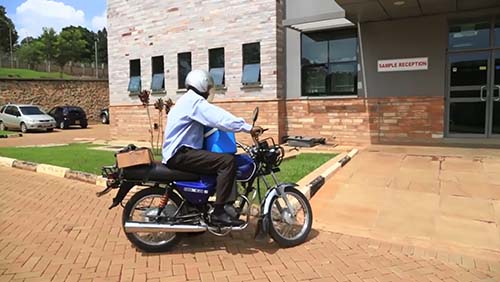
Efficient Sample Collection in Remote Areas
The main challenge faced by people in remote areas when it comes to HIV/AIDS testing is access. People in remote areas can be very poor, so it can be difficult for them to travel to the service point, although the treatment itself is free in Uganda.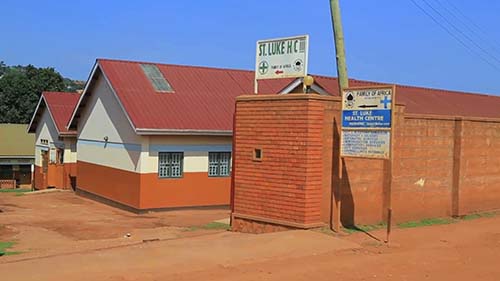
High Quality Testing in Rural Communities
The majority of countries still don’t have the infrastructure, transport or technology to effectively manage the collection, storage and transportation of the blood once the sample has been taken.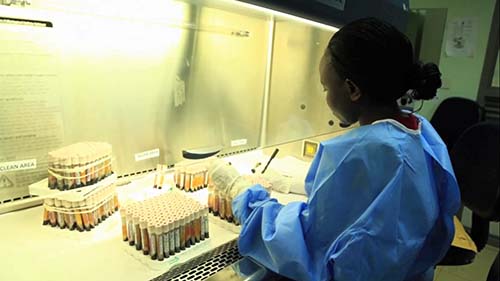
Demonstrating Operational Efficiencies: Part 1
Stimulating efficiency while empowering and mentoring local laboratory professionals in workflow management underpins the remarkable improvement in the routine laboratory service of Uganda’s West Nile Health Region.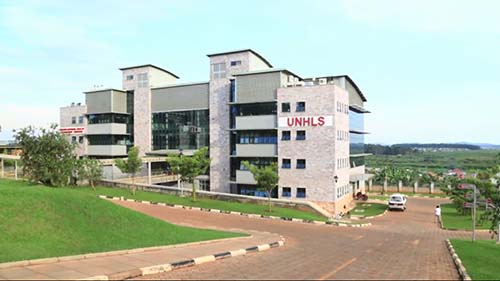
Demonstrating Operational Efficiencies: Part 2
Uganda’s Central Public Health Laboratories (CPHL) recognized that its regional laboratory service was suffering from a number of challenges that were affecting service delivery and patient outcomes.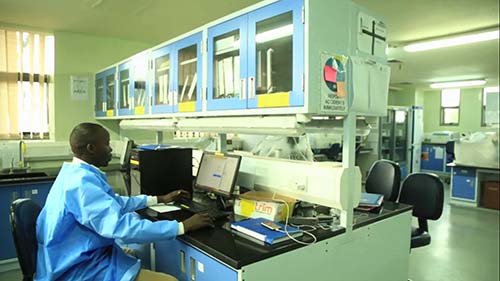
Demonstrating Operational Efficiencies: Part 3
The initial assessment found that supplies would be delayed, with frequent stock outs, due to poor communication because there was no clear chain of command for coordinating this activity.